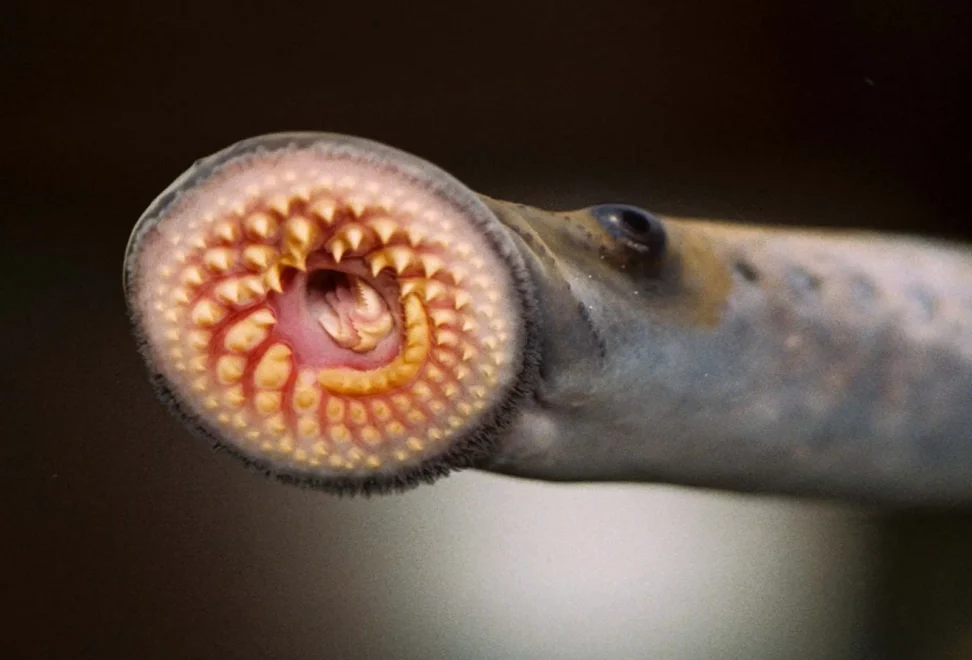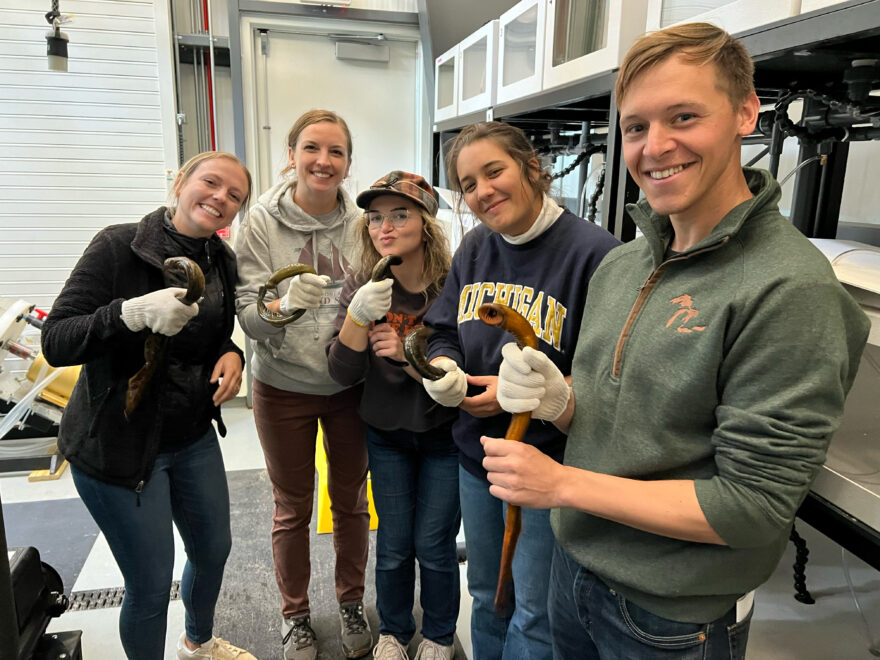As of 2023, there have been 188 non-native aquatic species identified in the Great Lakes. The impact these species have had on the Great Lakes varies widely, from mildly beneficial or simply benign to devastatingly harmful. One of the most well-known and prolific examples of a species that has wreaked havoc on the Great Lakes ecosystem is the sea lamprey (Petromyzon marinus).
Sea lampreys are a species of jawless, eel-like fish native to the Atlantic Ocean. They have cartilage but no bones, no scales, and no swim bladders. They are one of the most primitive fish species in the world, and have been around for more than 340 million years. A sea lamprey’s most defining feature is a round, suctioning mouth that is filled with rows of horned teeth and a file-like tongue. Sea lampreys use these mouths to latch onto and feed on large fish species. In their native oceanic range, the fish that sea lampreys prey on have coevolved with the lamprey, and are typically large enough to survive the attack. The same cannot be said for the fish of the Great Lakes. Here, the fish are smaller and much less likely to escape a sea lamprey encounter unscathed. A single lamprey can kill more than 40 pounds of Great Lakes fish in one year, and under some conditions it is estimated that only 1 out of 7 fish survive a sea lamprey attack.

Sea lampreys first entered the Great Lakes during the early twentieth century. Their invasion was the result of development along the St. Lawrence Seaway, particularly the expansion of the Welland Canal in 1919. After their introduction, sea lampreys quickly decimated the Great Lakes fisheries. At the peak of the sea lamprey invasion, the upper Great Lakes saw a 98% reduction in the annual lake trout catch, and 85% of fish caught exhibited lamprey wounds. A multibillion dollar fishing industry was at risk, thousands of jobs were lost, and the ecosystem was nearing total collapse. The United States and Canada responded by forming the Great Lakes Fishery Commision (GLFC) in 1955. The primary goal of the GLFC was to save and restore the Great Lakes fishery, and the first step towards that goal was getting the sea lamprey problem under control.
Operating out of Hammond Bay Biological Station, the GLFC began researching a variety of different proposed sea lamprey control methods. The foremost goal was to find an effective lampricide that could target and destroy sea lampreys without causing harm to other
species. This proved to be a lofty task, but after testing over 6,000 different compounds, researchers found success. The first effective lampricide, TFM (3-trifluoromethyl-4-nitrophenol) was discovered in 1958. Since then, TFM has proved to be our best tool in the fight to control sea lampreys in the Great Lakes. In combination with other methods of control, such as barriers and traps that prevent adult lampreys from reaching their spawning grounds, the use of lampricides has dramatically reduced the number of sea lampreys in the Great Lakes. Sea lamprey populations have decreased 90% from their peak in the 1950s, and native fish populations are slowly recovering.
Recently, Inland Seas Education Team members had the opportunity to visit Hammond Bay Biological Station to learn more about their lamprey research and how we here at Inland Seas can work to incorporate education on sea lampreys into our own programs. We were graciously welcomed by Dr. Andrea Miehls, a communications associate and researcher at Hammond Bay who focuses her career on educating the greater public about sea lampreys and the overall impact of invasive species on Great Lakes ecosystems. Dr. Miehls gave us a tour of the station, and answered all of our burning questions about lampreys and their value in Great Lakes education. We were able to see and hear first hand about their ongoing research efforts, hold and interact with live lampreys, and meet researchers working at the station. By far, the highlight of our trip was when we were given the opportunity to witness an in-person sea lamprey dissection. Seeing and interacting with the lamprey’s internal lamprey gave us all an entirely new insight into how these aquatic vampires function and succeed (shout out to GLFC communications staff member, Meg Sigmon, who expertly performed the dissection!).

Having this opportunity to experience lampreys and lamprey research firsthand gave the entire team a new respect for the villainous species. Many people (including members of our team) have been taught to fear lampreys, but approaching discussions about this species from solely a place of fear leaves little room to learn from these fish. To this date, sea lampreys are the only Great Lakes invasive species that have been successfully controlled basin-wide. The effort to control sea lampreys has taught us an immense amount about Great Lakes conservation. The fight is not over though. Sea lamprey control efforts must indefinitely continue to be implemented and improved upon to prevent sea lamprey populations from rebounding. We can also use what we learn from the ongoing lamprey control initiative to improve the health of other aspects of the ecosystem.
Inland Seas is excited to implement what we learned at Hammond Bay into our Watershed Exploration programming. To get us started on this venture, the lovely folks at Hammond Bay Biological Station sent us on our way with one final parting gift: a giant cooler containing 50 frozen sea lampreys. It is safe to say that by the end of this winter season, we all will be more familiar with the sea lamprey than we ever thought possible.
This blog post was written by ISEA Great Lakes Educator Lauren Sheffer. If you want to contribute your own Great Lakes story, please contact marketing@schoolship.org.